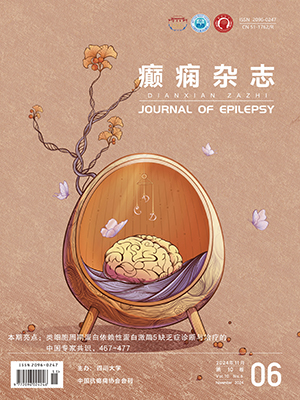| 1. |
张洁. 晕厥与癫痫的鉴别诊断. 中国实用神经疾病杂志, 2016, 19(16): 104-105.
|
| 2. |
Lempert T, Bauer M, Schmidt D. Syncope: a videometric analysis of 56 episodes of transient cerebral hypoxia. Ann Neurol, 1994, 36(2): 233-237.
|
| 3. |
Brodtkorb E. Common imitators of epilepsy. Acta Neurol Scand Suppl, 2013, 196(8): 5-10.
|
| 4. |
McCrory PR, Bladin PF, Berkovic SF. Retrospective study of concussive convulsions in elite Australian rules and rugby league footballers: phenomenology, aetiology, and outcome. BMJ, 1997, 314(7075): 171-174.
|
| 5. |
廖圣芳, 陈汉民, 张银清. 脑震荡性晕厥误诊为外伤性癫痫54例分析. 中国误诊学杂志, 2003, 23(8): 1206-1207.
|
| 6. |
Benbadis SR, Allen Hauser W. An estimate of the prevalence of psychogenic non-epileptic seizures. Seizure, 2000, 9(4): 280-281.
|
| 7. |
Gedzelman ER, LaRoche SM. Long-term video EEG monitoring for diagnosis of psychogenic nonepileptic seizures. Neuropsychiatr Dis Treat, 2014, 10(5): 1979-1986.
|
| 8. |
Reuber M, Elger CE. Psychogenic nonepileptic seizures: review and update. Epilepsy Behav, 2003, 4(3): 205-216.
|
| 9. |
Mostacci B, Bisulli F, Alvisi L, et al. Ictal characteristics of psychogenic nonepileptic seizures: what we have learned from video/EEG recordings--a literature review. Epilepsy Behav, 2011, 22(2): 144-153.
|
| 10. |
姜颖. 癫痫诊断及鉴别诊断的临床思考. 中国医药指南, 2016, 14(11): 296-297.
|
| 11. |
杨志仙. 夜间发作癫痫的诊断与鉴别. 世界睡眠医学杂志, 2015, 2(6): 380-382.
|
| 12. |
Schulz UG, Rothwell PM. Transient ischaemic attacks mimicking focal motor seizures. Postgrad Med J, 2002, 78(918): 246-247.
|
| 13. |
Ali S, Khan MA, Khealani B. Limb-shaking transient ischemic attacks: case report and review of literature. BMC Neurol, 2006, 6(1): 5.
|
| 14. |
Ma QF, Huang Q, Zhang Q, et al. Association between clinical features and prognosis of patients with limb-shaking transient ischemic attack. Chin Med J (Engl), 2013, 126(22): 4354-4357.
|
| 15. |
Baquis GD, Pessin MS, Scott RM. Limb shaking−a carotid TIA. Stroke, 1985, 16(3): 444-448.
|
| 16. |
Irani SR, Michell AW, Lang B, et al. Faciobrachial dystonic seizures precede Lgi1 antibody limbic encephalitis. Ann Neurol, 2011, 69(5): 892-900.
|
| 17. |
张梅娟, 管得宁, 王晓云, 等. 面臂肌张力障碍型癫痫的临床特征以及预后. 中国神经免疫学和神经病学杂志, 2018, 25(6): 443-446.
|
| 18. |
Striano P. Faciobrachial dystonic attacks: seizures or movement disorder. Ann Neurol, 2011, 70(1): 179-180.
|
| 19. |
Bhatia KP. The paroxysmal dyskinesias. J Neurol, 1999, 246(3): 149-155.
|
| 20. |
黄啸君, 曹立, 陈生弟. 发作性动作诱发性运动障碍临床表现及遗传学研究进展. 中国现代神经疾病杂志, 2013, 13(5): 457-462.
|
| 21. |
Bruno MK, Hallett M, Gwinn-Hardy K, et al. Clinical evaluation of idiopathic paroxysmal kinesigenic dyskinesia: new diagnostic criteria. Neurology, 2004, 63(12): 2280-2287.
|
| 22. |
Axel L. Cerebral blood flow determination by rapid-sequence computed tomography: theoretical analysis. Radiology, 1980, 137(3): 679-686.
|
| 23. |
Kikuchi T, Nomura M, Tomita H, et al. Paroxysmal kinesigenic choreoathetosis (PKC): confirmation of linkage to 16p11-q21, but unsuccessful detection of mutations among 157 genes at the PKC-critical region in seven PKC families. J Hum Genet, 2007, 52(4): 334-341.
|
| 24. |
Bruno MK, Lee HY, Auburger GW, et al. Genotype-phenotype correlation of paroxysmal nonkinesigenic dyskinesia. Neurology, 2007, 68(21): 1782-1789.
|
| 25. |
Weber A, Köhler A, Hahn A, et al. Benign infantile convulsions (IC) and subsequent paroxysmal kinesigenic dyskinesia (PKD) in a patient with 16p11.2 microdeletion syndrome. Neurogenetics, 2013, 14(3-4): 251-253.
|
| 26. |
Waln O, Jankovic J. Paroxysmal movement disorders. Neurol Clin, 2015, 33(1): 137-152.
|
| 27. |
Tacik P, Loens S, Schrader C, et al. Severe familial paroxysmal exercise-induced dyskinesia. J Neurol, 2014, 261(10): 2009-2015.
|
| 28. |
Nobili L, Proserpio P, Combi R, et al. Nocturnal frontal lobe epilepsy. Curr Neurol Neurosci Rep, 2014, 14(2): 424.
|
| 29. |
Becchetti A, Aracri P, Meneghini S, et al. The role of nicotinic acetylcholine receptors in autosomal dominant nocturnal frontal lobe epilepsy. Front Physiol, 2015, 6(3): 22.
|
| 30. |
Liu XR, Huang D, Wang J, et al. Paroxysmal hypnogenic dyskinesia is associated with mutations in the PRRT2 gene. Neurol Genet, 2016, 2(2): e66.
|
| 31. |
Steinlein OK. Genetic heterogeneity in familial nocturnal frontal lobe epilepsy. Prog Brain Res, 2014, 213(6): 1-15.
|
| 32. |
Picard F, Makrythanasis P, Navarro V, et al. DEPDC5 mutations in families presenting as autosomal dominant nocturnal frontal lobe epilepsy. Neurology, 2014, 82(23): 2101-2106.
|




